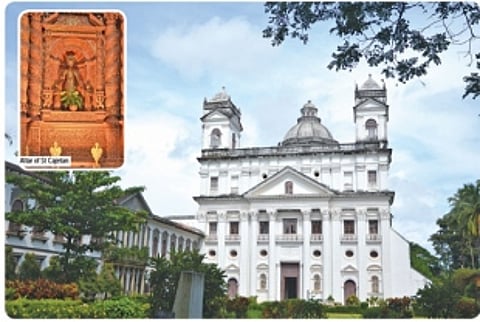

St Cajetan was born on October 1, 1480 in Vicenza, Italy. His parents were Kaitan Gosper
and Mary Porta. His father died when he was very small. He grew in holiness by
the good example of faith and good life of his mother. At the age of 24, he
graduated Civil Law and Connon Law in flying colours. He held many important
positions at different phases and times in Church.
On September 30, 1516
he was ordain priest in Rome. He joined the Society of Love of God in order to
promote the Blessed Sacrament and the devotion to Mother Mary. In 1522, he
renounced all his earthly riches and started living entirely on the providence
of God. He opened a hospital in his native village for the sick and this
congregation also built a hospital for the needy in the city of Old Goa. On
September 14, 1524, he founded a society called Clerigos Regulares da Divina
Providencia, which was later named the congregation of ‘Theatines’. Members
of this congregation could not buy property nor ask for alms in order to
survive; they had to only sustain on divine providence, relying only on what
people offered on their own accord.
In order to help the
poor, he founded the fund of (Mercy Fund), which later became the Bank of
Naples.
Saint Cajetan died on
August 7, 1547, and was buried in Paolo Naggiore Church. Pope Urban declared
him blesses on October 8, 1629. He was declared Saint by Pope Clement X on
April 12, 1671. He is invoked by those who are seeking jobs. The Theatines
built a church in the holy city of Old Goa, which is dedicated to Divine
Providence, which is attached to recent Pastoral Institute (Pius X) and
Convent. On the North East of the Church, every year, the Pastoral Institute,
along with their clergies, Pastoral Council and faithful from surrounding
villages celebrate the feast of St Cajetan on August 7 every year after
completing nine days Novenas.
This marvellous
architecture piece that the church is, was built after the style of St Peter’s
in Rome. The Church and the Convent were completed in 1661, subsequently the
convent was enlarged later in the northern side. There’s a hemispherical cupola
and a beautiful Corinthian facade looking towards the west. It has four niches
with ash grey granite images of St Peter, St Paul, St John and St Matthew.
Italian father D Carlo Ferrarini and lay brother Francesco Maria Milazzo were
the architects. Mestre Inacio was the sculptor and Manuel Pereira was the
builder. The following words of Christ are painted in bold letters on the
threshold: Domus mea domus orationis (My house is a house of prayer).
There are six alters beside the main alter.
Today’s pastoral
Institute of St Pius building for the internship of diocesan priests was
formally the convent of St Cajetan.
The church is divided
into one nave and two aisles and six vaulted chapels on the sides. As you
enter, to the right the chapel of St Andrew Avelino, the chapel of St Cajetan,
the chapel of St Catherin, to the left, the chapel of Holy Family, the chapel
of the Redeemer and Our Lady of Dolours, the chapel of St Gregory the interesting
thing about this Church it has two sacristies on the either side.
The main alter
dedicated to Nossa Senhora da Divina Providencia (Our Lady of Divine
Providence) this alters are profusely gilded in Baroque style now it is getting
faded and dull. On the socle of the alter, six young angels stand on pedestals,
holding shield that rests on those pedestals, three on the each side of the
niche.
The chapel of St
Cajetan in between the chapels to the right. A big statue of St Cajetan stands
in the centre of the niche.
On
the sides of the alter, beautiful paintings depicting scenes of the saints.
Theatines also had an autographed letter of St Cajetan, which was brought when
they first arrive in Goa.